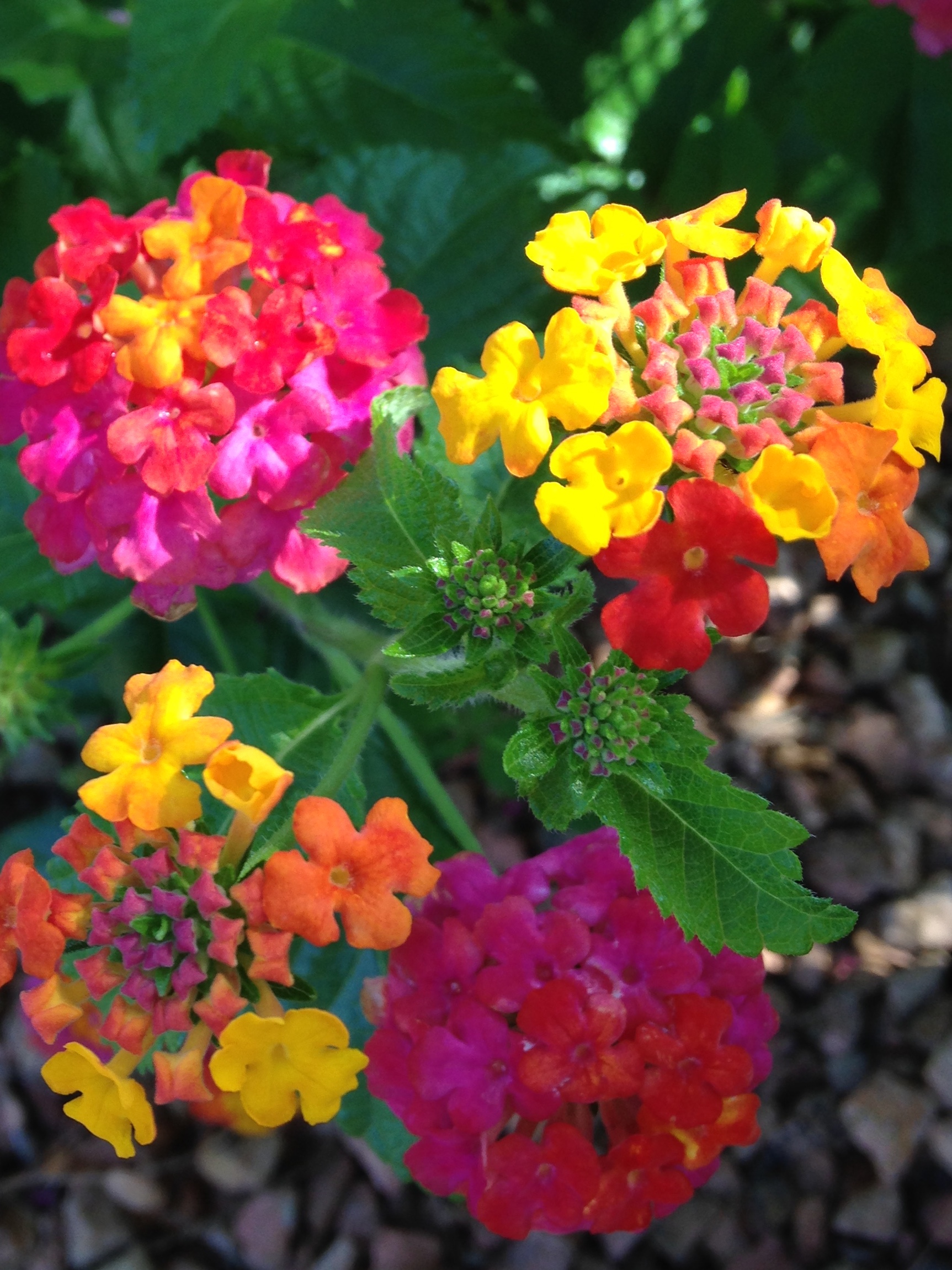Plant of The Month: Lantana

by Jan Koehler, SCMG Intern
Scientific Name: Lantana camara
Other Common Name: Lakanam, shrub verbena, yellow sage, red sage
Type: Perennial/annual depending in which zone planted and NM garden microclimate
Family: Verbenacae
Native Range: Tropical America and West Africa
Zone: Top growth hardy USDA zones 10-11, roots hardy USDA zones 9
Height: 3’-4’ with spread 1’-3’
Bloom Time: July to frost
Bloom Description: White, yellow, orange, red. Purple, often mixed in same cluster
Sun: Full
Water: Medium
Soil: Average, medium, well-drained
Maintenance: Low
Flower: Showy
Leaf: Fragrant
Tolerate: Drought, poor soil
Attracts: Butterflies, hummingbirds
Suggested use: Annual bedding plant, containers
Problems: Powdery mildew, white flies, lace bugs, toxicity if ingested by pet/agricultural animals
Culture and Care
Native to the Central and South America and West Africa, this species of lantana (also commonly called shrub verbena) is an upright frost-tender shrub that grows 3-6’ tall. It has escaped gardens throughout the world and is considered to be a noxious weed in many frost-free/tropical areas where it can rapidly spread to form dense thickets. It has naturalized in parts of the southern U.S. including southern Florida, the Gulf Coast and southern California. When grown in Sandoval County, NM, plants should be placed out in spring after last frost date and may grow to as much as 3-4’ tall by the end of the summer. They prefer warm temperatures so new growth may be slow to appear. Once the temperatures warm up though, they will grow abundantly. Tiny 5-lobed flowers in dense hemispherical clusters (to 2” diameter) bloom summer to fall, which is why these verbena-like flowers have long been admired. Flower colors include white, yellow, orange, red and purple, often mixed in the same cluster. Each flower is tubular with 4 lobes flaring to about 1/4 inch, initially yellow or pink gradually changing to orange and deep red. The dark green leaves are opposite, ovate, 1-5 inches long and 1-2 inches wide, with very small rounded teeth, somewhat rough and wrinkled above. Leaves are aromatic when bruised.
The growing and care of lantanas (Lantana camara) is easy. Simply choose a sunny location and plant them in well-draining soil. Although these plants are tolerant of many soil conditions, lantana flowers prefer slightly acidic soil. There are several varieties available that offer a multitude of colors. Depending on the region and type grown, lantana plants can be treated as annuals or perennials. Lantana flowers are often used in containers. Trailing varieties can even be grown in hanging baskets.
So many cultivars and hybrids are available, including dwarf plants, that the species plant is seldom found commercially. Flowers are attractive to butterflies and hummingbirds.
Lantana Plant Maintenance
While newly planted Lantana requires frequent watering, once they are established, these plants require little maintenance and are even tolerant of somewhat dry conditions.
Although it isn’t required, lantana plants can be given a light dose of fertilizer each spring if planted in a perennial growing microclimate in Sandoval County, but too much may inhibit their overall flowering offering only a superb vegetation display.
To encourage re-blooming, deadhead periodically. If they have been planted in a microclimate conducive to a perennial condition in Sandoval County, they should be cut back to the ground in late winter/early spring so the new growth can appear from the roots when the weather warms sufficiently.
Conditions of Poisoning
Pasture animals with sufficient forage will often avoid Lantana, perhaps because of its pungent aroma and taste, but animals unfamiliar to the plant may ingest enough to affect them. Fifty to ninety percent of animals newly exposed may be affected. Foliage and berry-like fruit, which is fleshy, greenish-blue to black when ripe, containing one seed contain the toxic substances with the toxins being in higher concentrations in the green unripe berries. Species affected include cattle, sheep, horses, dogs, guinea pigs, and rabbits.
Common Problems with Growing Lantanas
While lantanas are not affected by too many problems; you may encounter them on occasion. Powdery mildew can become a problem if the plant is not given enough light. In addition, the plant may develop root rot if it is kept too wet. Sooty mold is a condition that causes black discoloration on the leaves and is most often attributed to insect pests, such as whiteflies. Other common pests that affect lantana plants include lace bugs, which cause the foliage to turn gray or brown and then drop off.
More information:
http://plants.usda.gov/core/profile?symbol=LACA2
http://www.missouribotanicalgarden.org/PlantFinder/PlantFinderDetails.aspx?kempercode=a523
http://www.gardeningknowhow.com/ornamental/flowers/lantana/lantana-plants.htm
